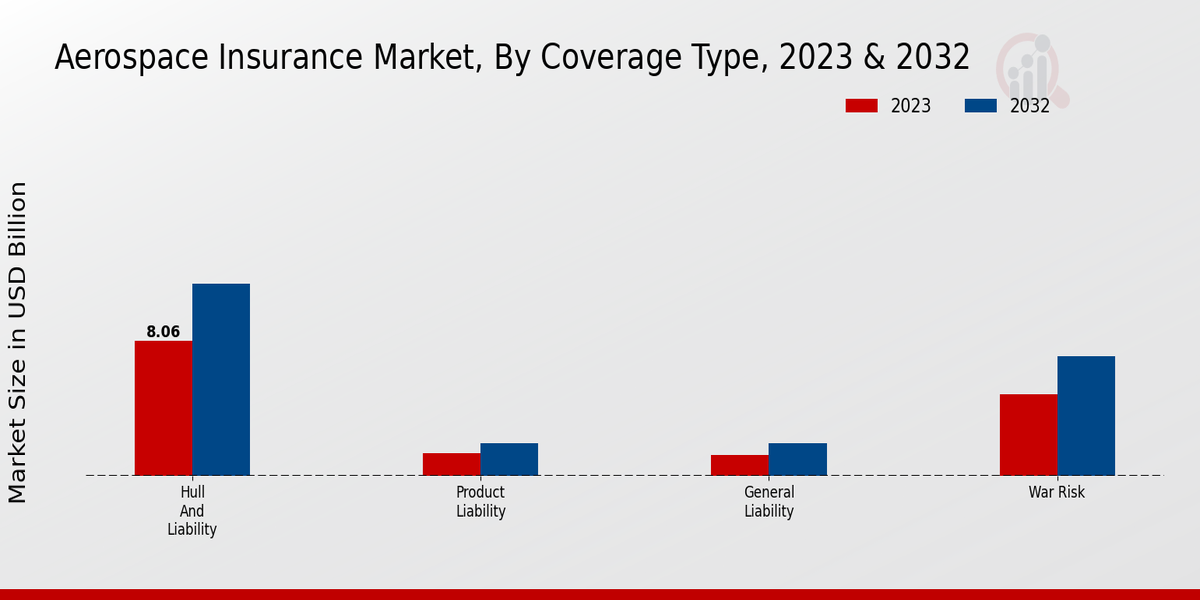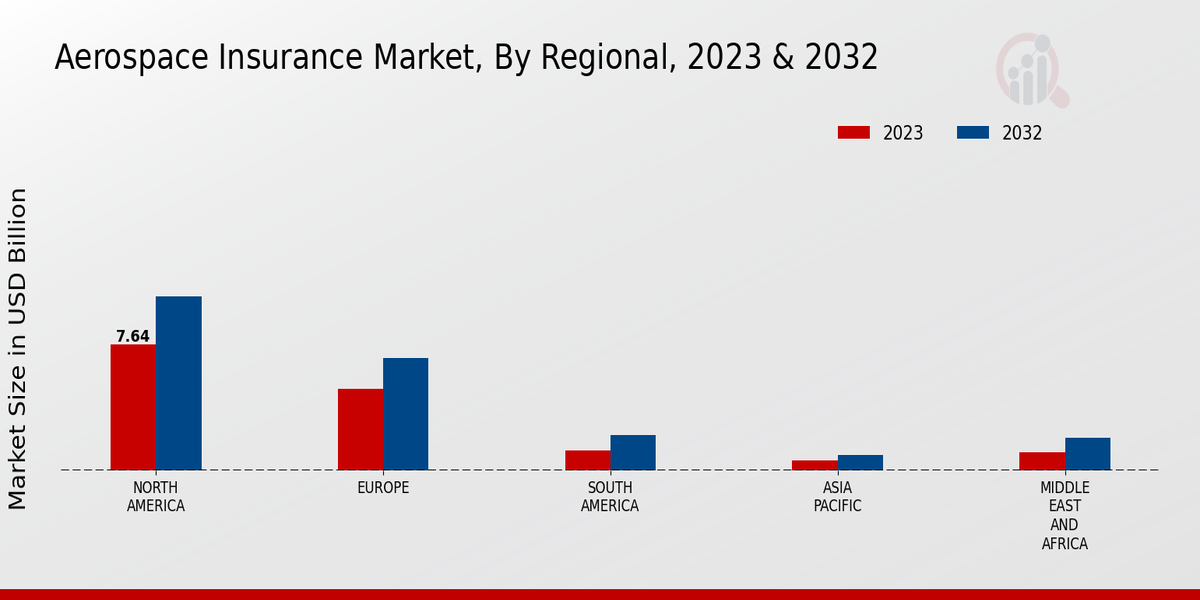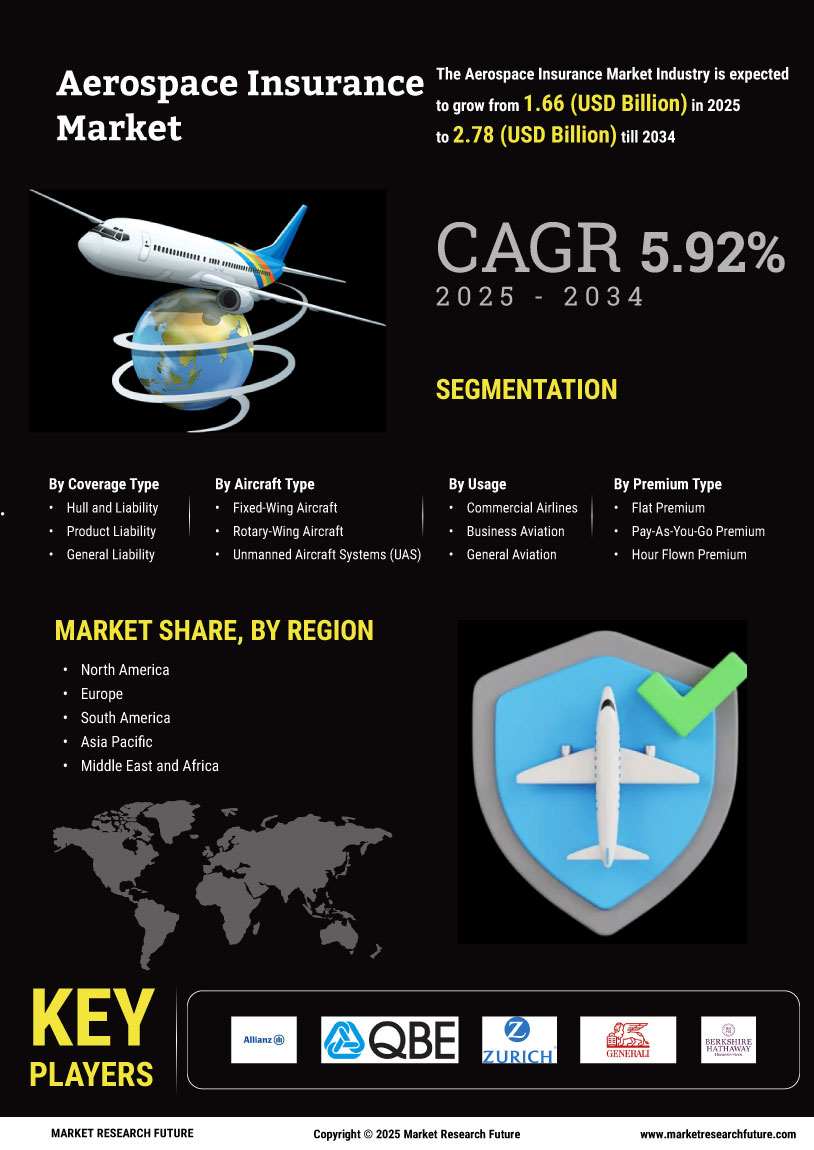Global Aerospace Insurance Market Overview:
Aerospace Insurance Market Size was estimated at 1.56 (USD Billion) in 2024. The Aerospace Insurance Industry is expected to grow from 1.66 (USD Billion) in 2025 to 2.78 (USD Billion) till 2034, exhibiting a compound annual growth rate (CAGR) of 5.92% during the forecast period (2025 - 2034).
Key Aerospace Insurance Market Trends Highlighted
The aerospace insurance market is witnessing a surge in demand driven by the increasing prevalence of unmanned aerial vehicles (UAVs), drones, and commercial space flights. The growing emphasis on maintaining safety and mitigating risks in the aerospace industry has fuelled the need for comprehensive insurance coverage. Key market drivers include the expansion of the global aerospace supply chain, technological advancements in aircraft manufacturing, and strict regulatory compliance requirements.
The investigation of parametric insurance, which bases coverage on predetermined factors rather than actual losses, presents growth opportunities. Additionally, insurers can customize pricing models and policies to individual risks by integrating data-driven technologies and advanced analytics. Recent trends point to a move toward proactive risk management strategies and predictive modeling. Predictive analytics is being used by insurers to identify possible hazards and create mitigation techniques, which allows them to provide more affordable and risk-adjusted premiums. The insurance industry is undergoing a trend of consolidation whereby prominent firms engage in mergers and acquisitions, resulting in the formation of larger and more varied insurance groups.

Source: Primary Research, Secondary Research, MRFR Database and Analyst Review
Aerospace Insurance Market Drivers
Increasing Demand for Aerospace Vehicles
The primary driver driving the expansion of the Aerospace Insurance Market industry is the rising demand for aerospace vehicles. The demand for private jets, commercial airplanes, and other aerospace vehicles is rising due to the rise of the global aerospace sector, improved air travel, and increased need for air freight services. Because of the growing need for travel and the continued expansion of the global economy, the demand for aircraft vehicles is expected to continue growing positively in the years to come.It is anticipated that as the market for aerospace vehicles grows, so will the need for aerospace insurance, as businesses need to safeguard their assets against potential liabilities, damage, and accidents.
Growing Awareness of Aerospace Insurance
Another major driver of the Aerospace Insurance Market Industry is the growing awareness of aerospace insurance. Companies are realizing that insurance helps in safeguarding their assets and reducing incurring risks. This is because of the growing number of accidents and incidents involving aerospace vehicles. The increased cost of repairing and replacing aerospace vehicles is also a factor. The growing awareness of aerospace insurance is expected to continue throughout the forecast period as companies learn more about the risks associated with operating aerospace vehicles.
Increasing Stringency of Aerospace Regulations
Another major driver of the growth of the Aerospace Insurance Market Industry is the increasing stringency of aerospace regulations. Governments around the world are implementing increasingly stringent regulations on the operation of aerospace vehicles. These regulations are designed to improve safety and reduce the risk of accidents. They are expected to continue increasing in stringency in the coming years as governments seek to ensure the safety of the aerospace industry.
Aerospace Insurance Market Segment Insights:
Aerospace Insurance Market Coverage Type Insights
The Aerospace Insurance Market is segmented by coverage type into hull and liability, product liability, general liability, and war risk. The hull and liability segment is expected to account for the largest share of the market in 2023, owing to the high value of aircraft and the need for comprehensive coverage against risks such as damage or loss of the aircraft, third-party liability, and passenger liability. The product liability segment is also expected to grow significantly, driven by the increasing number of product recalls and lawsuits in the aerospace industry.
The general liability segment provides coverage for general liability risks such as bodily injury, property damage, and advertising injury. The growth of the market is expected to be driven by the increasing demand for air travel, the growing number of aircraft in operation, and the increasing awareness of the importance of insurance coverage in the aerospace industry. The market is also expected to benefit from the development of new technologies, such as autonomous aircraft and electric aircraft, which are expected to create new risks and insurance needs.
The key players in the Aerospace Insurance Market include AIG, Allianz, AXA, Chubb, and Zurich Insurance Group. These companies offer a wide range of aerospace insurance products and services, including hull and liability insurance, product liability insurance, general liability insurance, and war risk insurance. They also offer a variety of value-added services, such as risk management consulting and claims management.

Source: Primary Research, Secondary Research, MRFR Database and Analyst Review
Aerospace Insurance Market Aircraft Type Insights
Aircraft Type is a key segment of the Aerospace Insurance Market. The segment includes fixed-wing aircraft, rotary-wing aircraft, and unmanned aircraft systems (UAS). Fixed-wing aircraft are the most common type of aircraft insured, and they account for most of the Aerospace Insurance Market revenue. The Aerospace Insurance Market for fixed-wing aircraft is expected to grow from USD 9.5 billion in 2023 to USD 12.4 billion by 2032, at a CAGR of 3.5%. Rotary-wing aircraft, which include helicopters, are another important segment of the Aerospace Insurance Market.
The Aerospace Insurance Market for rotary-wing aircraft is expected to grow from USD 2.7 billion in 2023 to USD 3.6 billion by 2032, at a CAGR of 3.9%. Unmanned aircraft systems (UAS), also known as drones, are a rapidly growing segment of the Aerospace Insurance Market. The Aerospace Insurance Market for UAS is expected to grow from USD 0.8 billion in 2023 to USD 2.1 billion by 2032 at a CAGR of 12.5%. The growth of the UAS segment is being driven by the increasing use of drones for commercial and recreational purposes.
Aerospace Insurance Market Usage Insights
The Aerospace Insurance Market segmentation by Usage includes Commercial Airlines, Business Aviation, General Aviation, and Military. The commercial airlines segment held the largest market share in 2023 and is projected to continue its dominance throughout the forecast period. The growth of this segment can be attributed to the increasing number of air travelers and the rising demand for air cargo services. The business aviation segment is also expected to witness significant growth due to the increasing popularity of private jets among high-net-worth individuals and corporations.
The general aviation segment is expected to grow at a steady pace, driven by the increasing use of aircraft for recreational purposes. The military segment is expected to remain a key contributor to the Aerospace Insurance Market, with governments across the world investing heavily in their defense capabilities.
Aerospace Insurance Market Premium Type Insights
The Aerospace Insurance Market is segmented by Premium Type into Flat Premium, Pay-As-You-Go Premium, and Hour Flown Premium. Among these, the Flat Premium segment held the largest market share in 2023, accounting for over 50% of the Aerospace Insurance Market revenue. The Flat Premium segment is expected to continue to dominate the market over the forecast period, owing to its simplicity and ease of administration. The Pay-As-You-Go Premium segment is expected to witness significant growth over the forecast period, driven by the increasing adoption of pay-as-you-fly models by airlines and other aircraft operators.
The Hour Flown Premium segment is expected to grow at a moderate pace over the forecast period, due to its dependence on aircraft utilization rates.
Aerospace Insurance Market Policyholder Type Insights
The Policyholder Type segment plays a crucial role in shaping the Aerospace Insurance Market. Aircraft Operators, Aircraft Manufacturers, and Aircraft Lessors constitute the key segments within this market. Aircraft Operators hold the largest share of the market, accounting for around 60% of the Aerospace Insurance Market revenue in 2023. The increasing number of commercial airlines and the growing demand for air travel contribute to the dominance of this segment. Aircraft Manufacturers, on the other hand, account for approximately 25% of the market share.
The rising production of new aircraft, coupled with the need for comprehensive insurance coverage during the manufacturing and testing phases, drives the growth of this segment. Aircraft Lessors, representing around 15% of the market share, play a vital role in providing insurance solutions for leased aircraft, ensuring the protection of their assets and mitigating financial risks. The market growth for Aircraft Lessors is anticipated to remain steady due to the increasing demand for aircraft leasing arrangements.
Aerospace Insurance Market Regional Insights
The regional segmentation of the Aerospace Insurance Market offers insights into the market's geographical distribution and growth patterns. North America dominates the market, driven by factors such as the presence of major aerospace companies, stringent regulations, and high insurance penetration. Europe holds a significant share, supported by a strong aviation sector and advanced insurance infrastructure. APAC is witnessing rapid growth, fueled by the expansion of the aerospace industry and increasing insurance awareness. South America has a relatively smaller market size but exhibits potential for growth due to increasing investment in infrastructure and aviation.
MEA presents opportunities for growth as governments prioritize the development of their aerospace sectors.

Source: Primary Research, Secondary Research, MRFR Database and Analyst Review
Aerospace Insurance Market Key Players And Competitive Insights:
Major players in the aerospace insurance market are constantly striving to gain a competitive edge by developing innovative products and services, expanding their geographic reach, and forming strategic partnerships. Leading Aerospace Insurance Market players are investing heavily in research and development to create tailored insurance solutions that meet the evolving needs of the aerospace sector. The development of the aerospace insurance market is driven by factors such as increasing demand for air travel, growth in the commercial aviation sector, and technological advancements in the aerospace industry. The competitive landscape is expected to remain dynamic, with new entrants and established players vying for market share.
A leading company in the Aerospace Insurance Market, Allianz Global Corporate & Specialty (AGCS) offers a comprehensive range of insurance solutions tailored to the specific risks faced by the aerospace industry. AGCS provides coverage for various aspects of aerospace operations, including aircraft hull and liability, space launch and satellite insurance, and aviation war and terrorism risks. The company has a strong global presence and a team of experienced underwriters who specialize in the aerospace sector. AGCS is committed to providing innovative and customized insurance solutions to meet the evolving needs of its clients.
A key competitor in the Aerospace Insurance Market, AIG, offers a wide range of insurance products and services to the aerospace industry. AIG provides coverage for aircraft, spacecraft, and satellites, as well as liability, accident, and health insurance for aviation professionals. The company has a long history in the aerospace insurance market and has developed a deep understanding of the industry's unique risks. AIG is focused on providing tailored insurance solutions that meet the specific needs of its clients and is committed to delivering superior customer service.
Key Companies in the Aerospace Insurance Market Include:
- Allianz
- QBE
- Zurich Insurance Group
- Generali
- Berkshire Hathaway
- Liberty Mutual
- Munich Re
- Travelers
- Hiscox
- AIG
- Swiss Re
- Tokio Marine
- Lloyd's of London
- Chubb
- AXA
Aerospace Insurance Industry Developments
Recent developments in the Aerospace Insurance Market include the increasing use of data analytics to improve risk assessment and pricing. Insurers are also developing new products and services to meet the evolving needs of the aerospace industry, such as coverage for drones and space tourism. The market is expected to grow in the coming years due to the increasing demand for air travel and the growing number of aerospace companies.
Some of the current affairs in the Aerospace Insurance Market include the impact of the COVID-19 pandemic on the aviation industry. The pandemic has led to a significant decline in air travel, which has, in turn, reduced the demand for aerospace insurance. However, the market is expected to rebound as the aviation industry recovers.
Aerospace Insurance Market Segmentation Insights
Aerospace Insurance Market Coverage Type Outlook
- Hull and Liability
- Product Liability
- General Liability
- War Risk
Aerospace Insurance Market Aircraft Type Outlook
- Fixed-Wing Aircraft
- Rotary-Wing Aircraft
- Unmanned Aircraft Systems (UAS)
Aerospace Insurance Market Usage Outlook
- Commercial Airlines
- Business Aviation
- General Aviation
- Military
Aerospace Insurance Market Premium Type Outlook
- Flat Premium
- Pay-As-You-Go Premium
- Hour Flown Premium
Aerospace Insurance Market Policyholder Type Outlook
- Aircraft Operators
- Aircraft Manufacturers
- Aircraft Lessors
Aerospace Insurance Market Regional Outlook
-
North America
-
Europe
-
South America
-
Asia Pacific
-
Middle East and Africa
| Report Attribute/Metric |
Details |
|
Market Size 2024
|
USD 1.56 Billion
|
|
Market Size 2025
|
USD 1.66 Billion
|
|
Market Size 2034
|
USD 2.78 Billion
|
|
Compound Annual Growth Rate (CAGR)
|
5.92% (2025-2034)
|
| Report Coverage |
Revenue Forecast, Competitive Landscape, Growth Factors, and Trends |
|
Base Year
|
2024
|
|
Market Forecast Period
|
2025-2034
|
|
Historical Data
|
2020-2023
|
| Market Forecast Units |
USD Billion |
| Key Companies Profiled |
Allianz, QBE, Zurich Insurance Group, Generali, Berkshire Hathaway, Liberty Mutual, Munich Re, Travelers, Hiscox, AIG, Swiss Re, Tokio Marine, Lloyd's of London, Chubb, AXA |
| Segments Covered |
Coverage Type, Aircraft Type, Usage, Premium Type, Policyholder Type, Regional |
| Key Market Opportunities |
Growing demand for commercial aircraft.Increase in air cargo volume.Expansion of the space tourism industry.Growing demand for unmanned aerial vehicles UAVs.Increase in cyber threats to aerospace systems |
| Key Market Dynamics |
Increased Demand for Space Tourism.Growing Commercial Aerospace Sector.Advancements in Unmanned Aerial Vehicles UAV Technology.Shifting Regulatory Landscape Rising Cyber Threats. |
| Countries Covered |
North America, Europe, APAC, South America, MEA |
Frequently Asked Questions (FAQ) :
The Aerospace Insurance Market size was valued at USD 1.66 billion in 2025 and is expected to reach USD 2.78 billion by 2034, exhibiting a CAGR of 5.92% during the forecast period.
North America is expected to dominate the Aerospace Insurance Market, accounting for a significant market share during the forecast period. The region's dominance is attributed to the presence of major aerospace manufacturers, such as Boeing and Lockheed Martin, as well as strict regulations and high insurance penetration rates.
The growth of the Aerospace Insurance Market is primarily driven by the increasing demand for commercial and military aircraft, stringent government regulations, rising awareness about the need for insurance coverage, and technological advancements in the aerospace industry.
Aerospace Insurance finds applications in various sectors, including commercial airlines, private aviation, military aviation, space exploration, and satellite operations. It covers risks associated with aircraft, spacecraft, satellites, and related equipment, providing financial protection against accidents, damage, and liabilities.
Some of the key competitors in the Aerospace Insurance Market include Allianz, AIG, AXA XL, Beazley, Berkshire Hathaway Specialty Insurance, Chubb, Generali, Liberty Mutual Insurance, Munich Re, and Zurich Insurance Group.
What are the challenges faced by the Aerospace Insurance Market?
Emerging trends in the Aerospace Insurance Market include the adoption of telematics and data analytics, the rise of unmanned aerial vehicles (UAVs), the development of space tourism, and the increasing focus on sustainability and risk management.
The Aerospace Insurance Market is expected to grow at a CAGR of 5.92% from 2025 to 2034.
The growth of the Aerospace Insurance Market in the Asia-Pacific region is driven by factors such as the increasing demand for air travel, the expansion of commercial and military aviation fleets, and the growing awareness of risk management practices.
New entrants in the Aerospace Insurance Market can find opportunities in regions with high growth potential, such as the Asia-Pacific region, by offering specialized insurance products, leveraging technological advancements, and partnering with local insurers to gain market share.

















